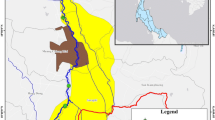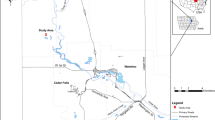Abstract
The boundary filtration effect of land/water ecotones with reed-bed/ditch systems under water level fluctuations was studied in Baiyangdian Lake of North China. It was found that the changes in reed bed areas which were primarily affected by water level fluctuations and the root channels in the wetland soils together largely determined boundary filtration efficiency. The ecotones displayed the greatest boundary effect at a moderate water level of about 8 m above sea level. The massive root channels in the wetland soils promoted water flowing into the reed beds as far as 8 m horizontally by subsurface in wet years. In dry years, when the water level was below the root channel distribution zone, the lateral water exchange width of ecotones was limited to 0.5 m along the fringe area. It is calculated that, at 8 m water level, the total boundary length of ecotones is 7,273 km and the boundary exchange volume is 5.8 × 106 m3. While at 6.5 m water level, the total boundary length of ecotones is reduced to 2,699 km and the boundary exchange volume is 1.1 × 105 m3. The standard capacity for phosphorus retention was 105.9 and 2.5 tonnes at water levels of 8 and 6.5 m, respectively. This suggests that the boundary filtration effect of reed-bed/ditch wetlands is important for improving the water quality of inland waters, and this effect should be considered in regulating and managing lake water levels.






Similar content being viewed by others
References
Bertrand AR (1965) Rate of water intake in the field. In: Black CA (ed) Methods of soil analysis. Part 1. Physical and mineralogical methods. Agronomy monograph number 9. American Society of Agronomy, Madison, pp 197–209
Beven K, Germann P (1982) Macropores and water flow in soils. Water Resour Res 18:1311–1325
Bodensteiner LR, Gabriel AO (2003) Response of mid-water common reed stands to water level variations and winter conditions in Lake Poygan, Wisconsin, USA. Aquat Bot 76:49–64
Brix H (1999) The European research project on reed die-back and progression (EUREED). Limnologica 29:5–10
Busse LB, Gunkel G (2001) Riparian alder fens—Source or sink for nutrients and dissolved organic carbon?—1. Effects of water level fluctuations. Limnologica 31:307–315
Casey RE, Taylor MD, Klaine SJ (2001) Mechanisms of nutrient attenuation in a subsurface flow riparian wetland. J Environ Qual 30:1732–1737
Cey EE, Rudolph DL, Aravena R, Parkin G (1999) Role of the riparian zone in controlling the distribution and fate of agricultural nitrogen near a small stream in southern Ontario. J Contam Hydrol 37:45–67
Cirmo CP, McDonnell JJ (1997) Linking the hydrologic and biogeochemical controls of nitrogen transport in near-stream zones of temperate-forested catchments: a review. J Hydrol 199:88–120
Compilation Committee of Local Chronicles of Anxin County (2000) Anxin county annals. Xinhua Publishing House, Beijing
Coops H, Theo Vulink J, van Nes EH (2004) Managed water levels and the expansion of emergent vegetation along a lakeshore. Limnologica 34:57–64
Coveney MF, Stites DL, Lowe EF, Battoe LE, Conrow R (2002) Nutrient removal from eutrophic lake water by wetland filtration. Ecol Eng 19:141–159
Dahm CN, Grimm NB, Marmonier P, Valett HM, Vervier P (1998) Nutrient dynamics at the interface between surface waters and groundwaters. Freshwater Biol 40:427–451
Devitt DA, Smith SD (2002) Root channel macropores enhance downward movement of water in a Mojave Desert ecosystem. J Arid Environ 50:99–108
Dinka M, Ágoston-Szabó E, Berczik Á, Kutrucz G (2004) Influence of water level fluctuation on the spatial dynamic of the water chemistry at Lake Fertõ/Neusiedler See. Limnologica 34:48–56
Dziejowski JE, Rimmer A, Steenhuis TS (1997) Preferential movement of oxygen in soils? Soil Sci Soc Am J 61:1607–1610
Fan C, Zhang L, Yang L, Huang W, Xu P (2002) Simulation of internal loadings of nitrogen and phosphorus in a lake. Oceanol Limnol Sin 33:370–378
Fesch C, Lehmann P, Haderlein SB, Hinz C, Schwarzenbach RP, Flühler H (1998a) Effect of water content on solute transport in a porous medium containing reactive micro-aggregates. J Contam Hydrol 33:211–230
Fesch C, Simon W, Haderlein SB, Reichert P, Schwarzenbach RP (1998b) Nonlinear sorption and nonequilibrium solute transport in aggregated porous media: Experiments, process identification and modeling. J Contam Hydrol 31:373–407
Feyen J, Jacques D, Timmerman A, Vanderborght J (1998) Modeling water flow and solute transport in heterogeneous soils: a review of recent approaches. J Agric Eng Res 70:231–256
Gaiser RN (1952) Root channels and roots in forest soils. Soil Sci Soc Am Proc 16:62–65
Gish TJ, Jury WA (1983) Effect of plant roots and root channels on solute transport. Trans ASAE 26:440–444, 451
Gopal B, Hillbricht-Ilkowska A, Wetzel RG (1993) Wetlands and ecotones: studies on land-water interactions. National Institute of Ecology, New Delhi, India, 301 pp
Gries C, Kappen L, Lösch R. (1990) Mechanism of flood tolerance in reed, Phragmites australis (Cav.) Trin. ex Steudel. New Phytol 114:589–593
Kadlec RH, Knight RL (1996) Treatment wetlands. CRC Press/Lewis Publishers, Boca Raton, FL, USA
Karr JR, Schlosser IJ (1978) Water resources and the land–water interface. Science 201:229–234
Kern J, Idler C (1999) Treatment of domestic and agricultural wastewater by reed bed systems. Ecol Eng 12:13–25
Li Y, Ghodrati M (1994) Preferential transport of nitrate through soil columns containing root channels. Soil Sci Soc Am J 58:653–659
Lüderitz V, Gerlach F (2002) Phosphorus removal in different constructed wetlands. Acta Biotechnol 22:91–99
Luederitz V, Eckert E, Lange-Weber M, Lange A, Gersberg RM (2001) Nutrient removal efficiency and resource economics of vertical flow and horizontal flow constructed wetlands. Ecol Eng 18:157–171
Mander Ü, Kuusemets V, Ivask M (1995) Nutrient dynamics of riparian ecotones: a case study from the Porijõgi River catchment, Estonia. Landscape Urban Plan 31:333–348
Naiman RJ, Décamps H (1997) The ecology of interfaces: Riparian zones. Ann Rev Ecol Syst 28:621–658
Naiman RJ, Décamps H, Fournier F (1989) The role of land/inland water ecotones in landscape management and restoration: a proposal for collaborative research. MAB Digest 4:19–43
Reddy KR, Kadlec RH, Flaig E, Gale PM (1999) Phosphorus retention in streams and wetlands: a review. Crit Rev Environ Sci Technol 29:83–146
Research Council on the Territory and Economy of Baiyangdian Lake (1987) Researches on the comprehensive harnessing and development of Baiyangdian Lake. Hebei People Press, Shijiazhuang
Riis T, Hawes I (2002) Relationships between water level fluctuations and vegetation diversity in shallow water of New Zealand lakes. Aquat Bot 74:133–148
Schmieder K, Dienst M, Ostendorp W, Jöhnk K (2004) Effects of water level variations on the dynamics of the reed belts of Lake Constance. Ecohydrol Hydrobiol 4:469–480
SEPA (2002) Environmental quality standards for surface water GB 3838–2002. State Environmental Protection Administration of China, The State Administration for Quality Supervision and Inspection and Quarantine (China), pp 1–9
Triska FJ, Duff JH, Avanzino RJ (1993) The role of water exchange between a stream channel and its hyporheic zone in nitrogen cycling at the terrestrial aquatic interface. Hydrobiologia 251:167–184
Vymazal J (2002) The use of sub-surface constructed wetlands for wastewater treatment in the Czech Republic: 10 years experience. Ecol Eng 18:633–646
Wang W, Wang D, Yin C (2002) A field study on the hydrochemistry of land/inland water ecotones with reed domination. Acta Hydrochim Hydrobiol 30:117–127
Wetzel RG (2001) Limnology: Lake and River Ecosystems, 3rd edn. Academic Press, San Diego, CA, USA
Xu W (2004) Reed land change and its relationship to water level change in Baiyang Lake. Master thesis, International Institute for Geo-Information Science and Earth Observation Enschede, the Netherlands
Xu W, Ouyang Z, van Duren I, Zheng H, Wang X, Miao H, Cao Q (2005) Reed land change and its relationship to water level in Baiyang Lake since 1987. J Soil Water Conserv 19:181–184, 189
Yin C, Lan Z (1995) The nutrient retention by ecotone wetlands and their modification for Baiyangdian Lake restoration. Water Sci Technol 32:159–167
Yin C, Shao X, Wang X (1999) Retention capacity of phosphorus and nitrogen by land/water ecotone soil in Lake Baiyangdian. Chin J Ecol 18:7–11
Zhao X, Cui B, Yang Z (2005) A study of the lowest ecological water level of Baiyangdian Lake. Acta Ecol Sin 25:1033–1040
Zhong P, Yang Z, Cui B, Liu J (2005) Studies on water resource requirement for eco-environmental use of the Baiyangdian Wetland. Acta Scientiae Circumstantiae 25:1119–1126
Acknowledgements
We thank Haiying Chen and Jing Jiang in the Baoding City Environmental Monitor Station of Hebei Province for their assistance in water sample analyses. Mr. Hongjun Wang is appreciated for his helpful comments on the manuscript. The authors thank Desiree D. Tullos and Alice S. Honig for editorial comments and language corrections. This research was funded by the National Basic Research Program of China (2006CB403306, 2002CB42308) and Innovation Program of the Chinese Ministry of Water Resources (SCX2003-02-04).
Author information
Authors and Affiliations
Corresponding author
Rights and permissions
About this article
Cite this article
Wang, W., Yin, C. The boundary filtration effect of reed-dominated ecotones under water level fluctuations. Wetlands Ecol Manage 16, 65–76 (2008). https://doi.org/10.1007/s11273-007-9057-3
Received:
Accepted:
Published:
Issue Date:
DOI: https://doi.org/10.1007/s11273-007-9057-3




